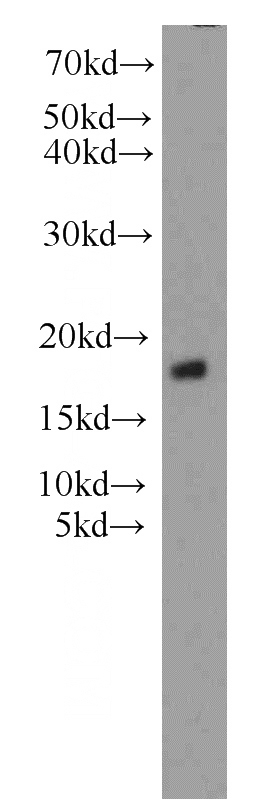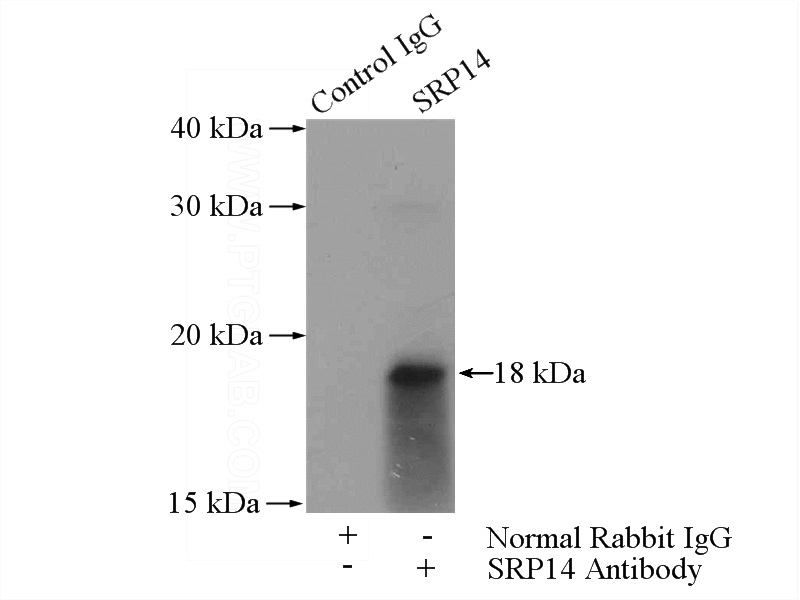-
Product Name
SRP14 antibody
- Documents
-
Description
SRP14 Rabbit Polyclonal antibody. Positive WB detected in A549 cells, HeLa cells, human heart tissue. Positive IP detected in A549 cells. Positive IF detected in MCF-7 cells, HepG2 cells. Observed molecular weight by Western-blot: 18 kDa
-
Tested applications
ELISA, IF, WB, IP
-
Species reactivity
Human; other species not tested.
-
Alternative names
18 kDa Alu RNA binding protein antibody; ALURBP antibody; SRP14 antibody
- Immunogen
-
Isotype
Rabbit IgG
-
Preparation
This antibody was obtained by immunization of SRP14 recombinant protein (Accession Number: NM_003134). Purification method: Antigen affinity purified.
-
Clonality
Polyclonal
-
Formulation
PBS with 0.1% sodium azide and 50% glycerol pH 7.3.
-
Storage instructions
Store at -20℃. DO NOT ALIQUOT
-
Applications
Recommended Dilution:
WB: 1:200-1:2000
IP: 1:200-1:1000
IF: 1:10-1:100
-
Validations

A549 cells were subjected to SDS PAGE followed by western blot with Catalog No:115590(SRP14 antibody) at dilution of 1:800

Immunofluorescent analysis of MCF-7 cells, using SRP14 antibody Catalog No:115590 at 1:25 dilution and Rhodamine-labeled goat anti-rabbit IgG (red).

IP Result of anti-SRP14 (IP:Catalog No:115590, 4ug; Detection:Catalog No:115590 1:300) with A549 cells lysate 1600ug.
-
Background
Signal recognition particle(SRP) acts in three distinct ways: 1 it binds to the signal sequence of the nascent polypeptide to be translocated, which is exposed on the surface of the translating ribosome; 2 it temporarily retards the nascent polypeptide from further elongation; 3 it mediates docking of the SRP–ribosome–nascent polypeptide chain complex to the RER membrane via the heterodimeric SRP-receptor (SR). SRP14 protein is a component of signal-recognition-particle that has a crucial role in targeting secretory proteins to the rough endoplasmic reticulum membrane. SRP9 together with SRP14 and the Alu portion of the SRP RNA, constitutes the elongation arrest domain of SRP. SRP14 form a heterodimer with SRP9, which recognizes Alu RNA and the related 7SL RNA.
-
References
- Jády BE, Ketele A, Kiss T. Human intron-encoded Alu RNAs are processed and packaged into Wdr79-associated nucleoplasmic box H/ACA RNPs. Genes & development. 26(17):1897-910. 2012.
- Piazzon N, Schlotter F, Lefebvre S. Implication of the SMN complex in the biogenesis and steady state level of the signal recognition particle. Nucleic acids research. 41(2):1255-72. 2013.
- Fittschen M, Lastres-Becker I, Halbach MV. Genetic ablation of ataxin-2 increases several global translation factors in their transcript abundance but decreases translation rate. Neurogenetics. 16(3):181-92. 2015.
Related Products / Services
Please note: All products are "FOR RESEARCH USE ONLY AND ARE NOT INTENDED FOR DIAGNOSTIC OR THERAPEUTIC USE"
